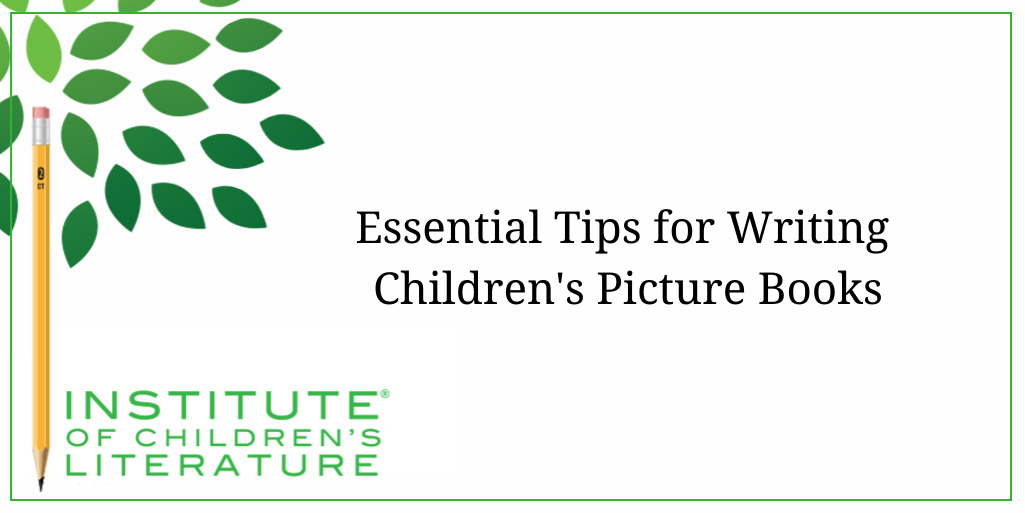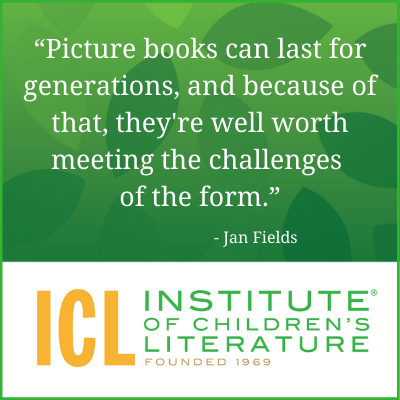
5 Ways Writers Can Prep for 2025 Goal Setting
Before we roll on to the new writing year, let’s harness our optimism for the blank slate before us and prepare for our 2025 Goal Setting just for writers.
Beginning Tuesday, July 22, 2025 at 10 PM CT through Wednesday, July 23, 2025 at 4 AM CT, we will be performing scheduled maintenance to update our website.

Writing children’s picture books is often about balancing surprisingly disparate items. Verbal storytelling is balanced against visual storytelling, as the work of the writer is paired with the work of the illustrator. Writers must consider the needs of the child who will be listening to the story versus the needs of the adult who will be reading it (and hopefully rereading it many times). The traditional elements of story content must balance against the extreme brevity of picture books and their need for euphony (beautiful sound). And the richness of the visual details must balance with other sensory details brought by the text: sounds, smells, and textures. For such tiny books, these are complex creations.
One of the most amazing things about the creation of a picture book is that it is a collaboration where the two collaborators rarely, if ever, communicate with one another. The writer crafts a story, usually from under 500 words, and then the illustrator is given the story to illustrate with only those few words to inspire a rich visual storytelling experience to match.

Sometimes the decisions of the illustrator can come as a surprise to the writer. A character that the writer pictures as a person might become a rather grand ostrich or maybe a cuddly bear when the illustrator jumps in. Because of this, it is essential that writers grasp that picture books are a collaborative experience.
The illustrator isn’t straitjacketed into trying to reproduce the words in pictures. Instead, the illustrator is meant to bring a different perspective. It is by seeing the same story through a completely different lens that picture books become the deep experience they are. Writers don’t get to micromanage illustrators (or manage them at all, except in self-published books).
So for the sake of your own joy in the experience, be ready to let go of how you imagined the illustrations so that the book can grow into the final product that is deep and unique.
Writing children’s picture books means creating books that please both children and adults. Board books are usually only a few words on the page and delight mostly by being bright and tactile for young children. And chapter books are a child’s step into independent reading. But picture books nestle in between. The story is important, but it must do double duty for child and parent. There are actually benefits from the fact that picture books aren’t intended to be read by a young child alone. Because of this, they don’t have the kind of controlled vocabulary that you’ll find in easy readers or early chapter books. Instead, the word choices can be rich and evocative. Consider the following excerpts from recent picture books:
“I’ll journey to the hidden depths of exotic jungles. I’ll sleep beneath the canopy of a million stars.”
– Little Blue Bunny, written by Erin Guendelsberger and illustrated by Stila Lim, Sourcebooks Wonderland.
“The voices of ancestors whisper in his ear, speaking in lilting languages of rice paddies climbing mountains like stairways to the sky.”
– Eyes That Speak to the Stars, written by Joanna Ho and illustrated by Dung Ho, Harper Collins.
Notice the use of words like exotic, canopy, ancestors, and lilting. These words would never appear in a book intended to be read by the child, but picture books have parents there to help with any words that might baffle the child, so authors are free to choose exactly the right word to result in the most beautiful language. The pleasure of reading such texts aloud makes the process enjoyable for both child and adult.
In picture books, the sights of the book are provided by the illustrator, but that doesn’t mean the author can’t bring in evocative sensory detail. For example, picture books are often full of wonderful sound effects. This kind of sensory detail works particularly well because picture books are meant to be read aloud. Consider these examples from recent books:
“Tap, tap, tap. Drip, drip, drip.
‘What’s that sound, Grandpa?’
‘It’s the sap running from the maples.'”
– Grandpa Alan’s Sugar Shack, written by Alan and Kamie Page and illustrated by David Geister. Page Education Foundation.
“At the last house, they heard screeching, meowing, barking, and squawking.”
– Marley and the Family Band, written by Cedella Marley and Tracey Baptiste, and illustrated by Tiffany Rose. Random House Books for Young Readers.
Picture books don’t always have traditional plots. Some are designed to explore a concept, often in lyrical ways (including classics like Guess How Much I Love You by Sam McBratney). Some are character studies that introduce the child to larger-than-life characters who are often very funny (like Olivia by Ian Falconer). Some capture a moment that shows the reader a beautiful relationship or a special place (like On a Wintry Morning, written by Dori Chaconas and illustrated by Stephen T. Johnson, or The Snowy Day by Ezra Jack Keats). Sometimes these plotless books become favorites that stand the test of time. One thing to realize about these plotless books is that a lack of plot doesn’t mean a lack of structure.

For example, in the recently published picture book Somewhere written by Robie H. Harris, and illustrated by Armando Mariño, a little girl on a walk with her father longs to go on her very own adventure. “Somewhere is where I wanted to go. Somewhere new. Somewhere I had never, ever been before.” With so few words, the book depends on the gorgeous illustrations to make that adventure real for the reader, so that the reader feels the adventure. The structure of the story is bound by the beginning when she is walking with her father, the middle, where she leaves to go on her own safe adventure, and the end, where she returns to his side. When they are reunited, the book comes to a satisfying conclusion.
A picture book especially needs that sense of ending in the actual text. Your manuscript should never end simply because you stopped adding examples. The book should be moving forward, toward some kind of point—building up to a peak moment, for instance, or maybe deconstructing to something very basic. Whatever structure you choose, it must be moving toward something that will feel like a satisfying ending. We’ll look more at picture books throughout the month, but keep in mind the complexity and balance you’ll need as you consider this unique art form.
Picture books can last for generations, and because of that, they’re well worth meeting the challenges of the form.
With over 100 books in publication, Jan Fields writes both chapter books for children and mystery novels for adults. She’s also known for a variety of experiences teaching writing, from one session SCBWI events to lengthier Highlights Foundation workshops to these blog posts for the Institute of Children’s Literature. As a former ICL instructor, Jan enjoys equipping writers for success in whatever way she can.

Before we roll on to the new writing year, let’s harness our optimism for the blank slate before us and prepare for our 2025 Goal Setting just for writers.

Writers can be thin-skinned when it comes to getting feedback on their work. Let’s look at 4 ways to positively deal with constructive criticism!

Rejection is part of the territory when it comes to being a writer. Today we offer reflection for writers to help redirect your efforts after a rejection.
1000 N. West Street #1200, Wilmington, DE 19801
© 2024 Direct Learning Systems, Inc. All rights reserved.
1000 N. West Street #1200, Wilmington, DE 19801
© 2024 Direct Learning Systems, Inc. All rights reserved.
1000 N. West Street #1200, Wilmington, DE 19801
© 2024 Direct Learning Systems, Inc. All rights reserved.
1000 N. West Street #1200, Wilmington, DE 19801
© 2025 Direct Learning Systems, Inc. All rights reserved.
1000 N. West Street #1200, Wilmington, DE 19801
©2025 Direct Learning Systems, Inc. All rights reserved. Privacy Policy.
5 Comments